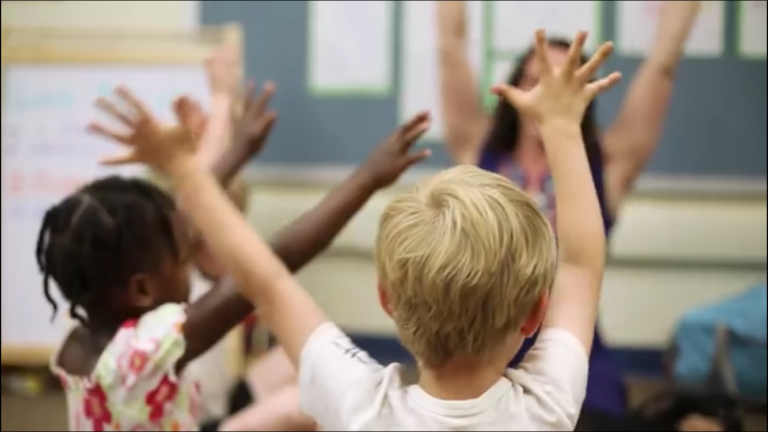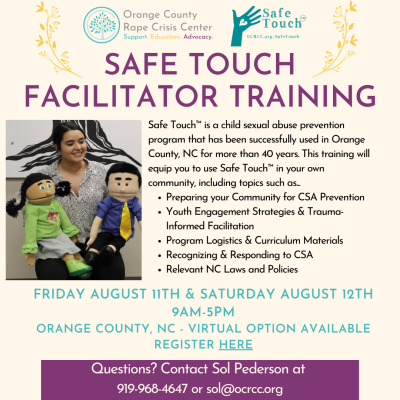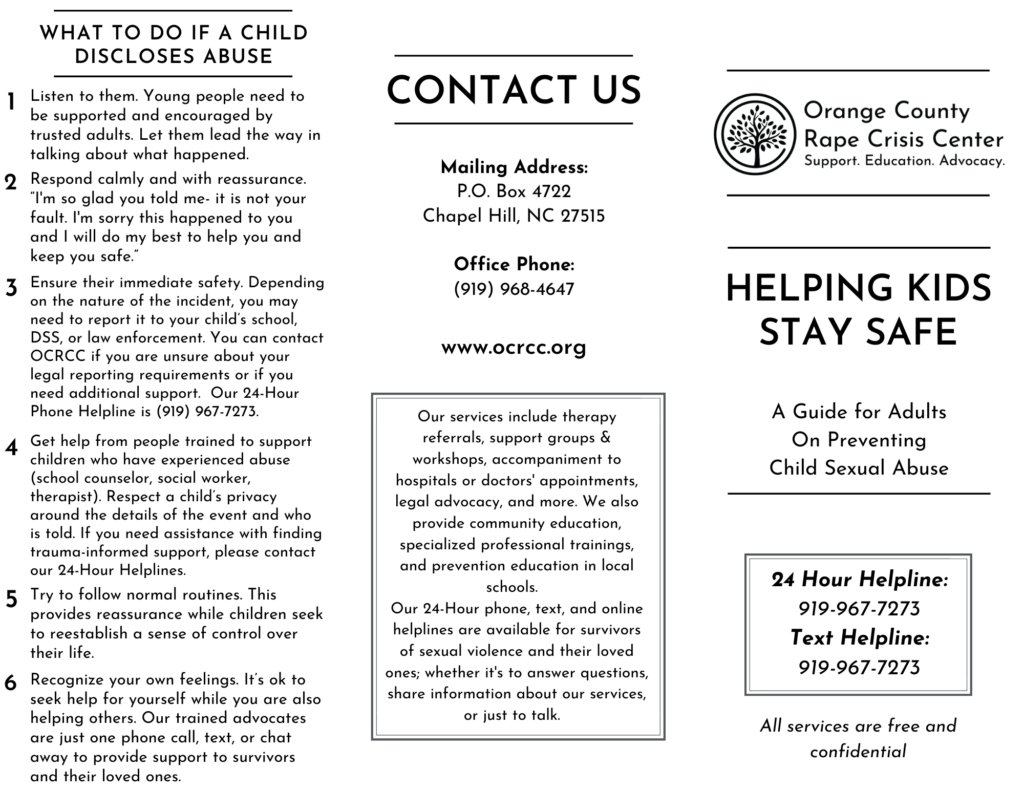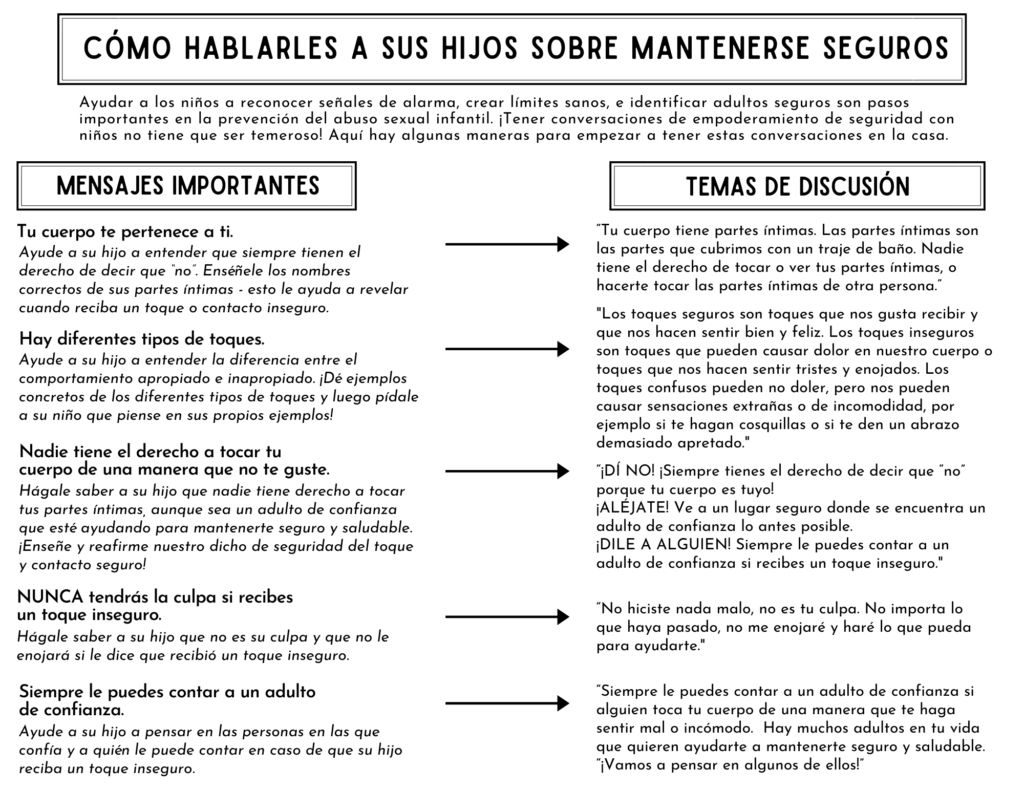24-Hour Helplines: Phone: (919) 967-7273 Text: (919) 967-7273
24-Hour Helplines: Phone: (919) 967-7273 Text: (919) 967-7273






By identifying touches as safe, unsafe, or confusing, students learn that no one should touch their body in a way that makes them feel unsafe or uncomfortable. Students learn the Safety Saying – say no, get away, tell someone – and practice expressing their boundaries. The program also addresses the idea of secrets and tricks while teaching children that it is never their fault if someone else violates safe boundaries. We work with students to identify adults both at home and at school that they can talk to if they ever feel unsafe or uncomfortable.
These messages are repeated each year with age-appropriate language and materials, and families receive materials to reinforce safety lessons at home. Safe Touch is designed for continuous learning: each year’s curriculum builds on the skills and knowledge taught in previous years, offering students a clear and sustained message about safety and achieving best results for preventing violence. Safe Touch programs are research-based, meeting national and school standards for personal safety education.
Click here to read the 2023 Safe Touch Evaluation Report, prepared by MSB Consulting.
We offer our educational programs in both English and Spanish, including a curriculum for students with intellectual and developmental disabilities. Safe Touch and Start Strong are offered in Orange County Schools and Chapel Hill-Carrboro City Schools. These programs are available to any group at an hourly rate, with additional access through a sliding scale. Please do not let cost be a barrier to bringing this content to your group.
All Safe Touch programs are currently being offered virtually live or pre-recorded.
Pre-K/Kindergarten | 20-30 minutes
Together we read a picture book called Safe Touches Only, students practice the Safety Saying, and puppets are used to role play age-appropriate situations.
1st Grade | 30 minutes
Students practice boundary setting, learning ‘your body belongs to you.’ Students learn a safety song and safe ways to tell someone when they are uncomfortable. Together we practice the Safety Saying and brainstorm trusted adults.
2nd Grade | 45 minutes
Students review and practice the Safety Saying. A puppet show addresses different types of abuse, with discussion emphasizing the importance of talking to a trusted adult. Students identify trusted adults and how to talk to them when they are uncomfortable.
3rd Grade | 45 minutes
A 15-minute video followed by discussion teaches students how to stand up for themselves in the face of abuse and how to talk to a trusted adult. Students use problem-solving skills to figure out how to be safe in situations involving games, tricks, and secrecy.
4th Grade | 45 minutes
Students learn about internet safety and digital citizenship, empowering them to reflect on their own internet use, identify safe practices, and practice positive communication. We introduce the concepts of cyberbullying and bystander intervention.
5th Grade | 60 minutes
Building on knowledge of bullying, this program shifts focus to unwanted attention from peers. Students learn what they can do and where to turn for help if they encounter sexual bullying.
Caregiver Discussion + Resource Guide: Body Safety
This guide is intended to support parents and caregivers in navigating body safety conversations with their kids.
Click here to download
Safe Touch Review Guide for Pre-K – 1st Grade Caregivers: Your Body Belongs to You
After receiving a Safe Touch lesson or having a talk about body safety, there are many ways to continue the conversation throughout the year. Below is a guide to help you reinforce the safety concepts your child has learned.
Click here to download
Tu cuerpo te pertenece: Guía de conversación (preescolar y 1er grado)
Safe Touch Review Guide for 2nd-3rd Grade Caregivers: Staying Safe
After Receiving a Safe Touch lesson or having a talk about body safety, there are many ways to continue the conversation throughout the year. Below is a guide to help you reinforce the safety concepts your child has learned.
Click here to download
Mantenerse seguro: Guía de conversación (2º y 3º grado)
Caregiver Lesson + Resource Guide: Internet Safety
Grades 3rd – 5th
Students are using the internet and technology now more than ever to keep up with schoolwork, friends, family, and entertainment. This guide is intended to support caregivers in navigating internet safety conversations with their kids.
Click here to download
Safe Touch Review Guide for 4th Grade Caregivers: Internet Safety + Cyberbullying
After receiving a Safe Touch lesson or having a talk about body safety, there are many ways to continue the conversation throughout the year. Below is a guide to help you reinforce the safety concepts your child has learned.
Click here to download
Seguridad en Internet + Ciberbullying: Guía de conversación (4to grado)
Caregiver Lesson + Resource Guide: Preventing Sexual Bullying
5th Grade
Caregivers are encouraged to use this guide with the accompanying Safe Touch Online video series, “Flirting Not Hurting: What is Sexual Bullying?”. The lesson is intended to provide information and skills to recognize the difference between flirting and sexual bullying, be aware of others’ boundaries, and engage in healthy communication.
Click here to download the lesson guide
Safe Touch Review Guide for 5th Grade Caregivers: Sexual Bullying
After receiving a Safe Touch lesson or having a talk about body safety, there are many ways to continue the conversation throughout the year. Below is a guide to help you reinforce the safety concepts your child has learned.
El Bullying Sexual: Guía de conversación(5to grado)
Safe Touch Coloring Book
“You Are a Special Person” is one of OCRCC’s take home materials from our Safe Touch programs. The story accompanying the coloring pages make this an excellent way to review body safety with your children and start important discussions at home! The language and images in this coloring book are designed to be age-appropriate for children ages 3-7, though it could be fun for anyone!
Click here to download in English
Click here to download in Spanish
Click here to download in Burmese
Click here to download in Karen
Feelings Thermometer and Coping Skills Chart
With this kid-friendly graphic you can build social and emotional learning by taking your feelings temperature. When you know how you feel, you can know how to take care of yourself!
Click here to download
Safe Touch Conversation Guide: No Secrets, Only Surprises: Sami’s Story
This is a conversation guide for adults discussing our Safe Touch video lesson with young people ages 7-11. “Sami’s Story” provides age-appropriate, kid-friendly language to help protect children from sexual abuse
Helping Kids Stay Safe Brochure
A Guide for Adults On Preventing Child Sexual Abuse








Child sexual abuse includes any sexual act between an adult and a minor or between two minors when one exerts power over the other. CSA includes forcing, coercing, or persuading a child to engage in any type of sexual act. It also includes non-contact acts such as exhibitionism, exposure to pornography, voyeurism, and communicating in a sexual manner by phone or the Internet.
Kids learn how to recognize inappropriate behavior and react when someone makes them uncomfortable. By teaching kids to “say no, get away, tell someone,” Safe Touch prevents abuse in several ways:
Our curriculum is truly comprehensive, with each year’s lesson building on the skills students have learned in the past years. Safe Touch aims to prevent sexual abuse by helping students fully understand safe and healthy relationships. By learning that “your body belongs to you” at a young age, children easily grasp the concept of consent when it is introduced as “flirting vs. bullying” in upper elementary and middle school. Start Strong, our middle school program, has a peer-to-peer focus, teaching tweens that sexual behaviors such as holding hands and hugging are only okay if the other person wants to do it. By learning to respect boundaries at a young age, teens have a deeper understanding of healthy relationships when they learn about communication, consent, and sexual assault in high school. Building key concepts and skills over several years allows students to learn boundaries, communication, and consent in a more effective, lasting way. Furthermore, our programs are based on the best available research, follow national best practice standards, and are provided by highly trained educators.
We offer Safe Touch programs in both English and Spanish, as well as a special curriculum for students with intellectual and developmental disabilities. Contact us to discuss how we can customize programs for your group.
“The [lessons] were all age-appropriate, and they did a good job of exposing students to these important issues without making them unnecessarily uncomfortable.”
Teacher
“I know that the Safe Touch program really empowered [my daughter]. Knowing that she has these skills and the understanding that her body is her own makes me sleep better at night!"
Parent
“The content was clear, simple, and age-appropriate. I personally felt empowered that I can teach my child appropriately in ways that will help her stay safe.”
Parent
Request a Safe Touch Program
Safe Touch programs are currently only available in North Carolina.


We support survivors of all types of sexual violence, such as rape, assault, harassment, stalking, sex trafficking, incest, and child sexual abuse. We are also available to talk to those who feel negatively impacted by a sexual experience. Our services are available to all members of the community regardless of race, socioeconomic class, gender identity and expression, sexual orientation, religion, disability, age, language, national origin, and immigration status.
1229 East Franklin St.
Chapel Hill, NC 27514
P. O. Box 4722
Chapel Hill, NC 27515
(919) 968-4647
Website Design by Carrboro Creative

